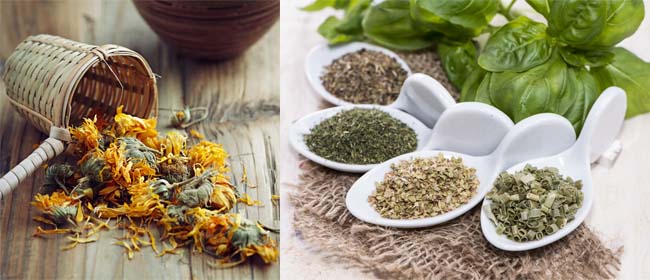
What do chives, lovage, dill, parsley and calendula have in common? They’re all ingredients in our homegrown herbal salt substitute, says editor Jane Wrigglesworth.
Most herbs, mixed into a comestible combo, will substitute for table salt, but the following recipe is one I’m sold on (though you can add other herbs or spices to taste). It takes five minutes to prepare and each of the herbs is dead easy to grow.
The recipe
Mix together:
½ cup dried chopped chives
1 tablespoon dried chopped lovage
½ cup dried chopped dill
½ cup dried chopped parsley
1 tablespoon dried chopped calendula flowers (white parts removed)
And that’s it! Can be sprinkled over any dish, including pizza. Store in an airtight container in a dark cupboard.
Chives
Chives (Allium schoenoprasum) require next to no attention once established other than a good watering when conditions are dry. Plants tend to attract black aphids when water stressed, so water regularly to keep your plants pest free. If your plants do attract aphids, just blast them with the hose or pour a bowl of soapy water over the whole plant.
Chives are sometimes referred to as common or onion chives to distinguish them from garlic chives (Allium tuberosum), although the two are different in appearance. The mild garlic-tasting leaves of garlic chives are wide and flat, while those of common chives are round and hollow. Garlic chives also have a white flower, common chives a pink flower.
Chives grow best in full sun but will benefit from a little shade during hot summers. They like a humus-rich soil, so dig in plenty of compost or well-rotted manure before planting.
If you’re a fan of chives, plant a minimum of three clumps (sow 10-20 seeds in a circle to form a clump). Harvest one clump (snip down to 5cm), then move on to the next. After harvesting an entire clump, feed with liquid fertiliser and leave it to develop a new set of leaves.
Lovage
Lovage (Levisticum officinale) tastes a lot like celery. It looks like celery too – an overgrown one – with shiny leaves that grow on straight, thickly rigid, hollow stems. In midsummer it produces tall flower stalks that reach 1.5-2m high. The flower heads are topped with umbels of yellow flowers, typical of members of the Umbelliferae family. All parts can be eaten – the roots, stems, leaves and seeds – but for our salt substitute recipe, use the leaves.
Lovage is one of the few herbs that grows well in part shade. It grows equally well in full sun, provided it’s given ample moisture. It likes a rich, moist but free-draining soil, so dig in plenty of compost.
Lovage conveniently self-sows, but if you don’t want a jungle of lovage, snip off the seed heads before the seeds form. The plant will die back in winter, but it emerges again in early spring.
Dill
At first sight, dill (Anethum graveolens) could be mistaken for fennel. It has similar feathery leaves and bright yellow flowers in flattened umbels, but if you look closely there are subtle differences. Dill’s leaves are blue-green, whereas fennel’s are yellow-green. Dill also throws up one main hollow stem from a single taproot; fennel throws up many stems, all solid, from a branched root system. Dill, an annual, is slightly smaller growing, at around 80cm high. Fennel, a perennial, grows up to 1.5m high.
Dill also has an aniseed taste like fennel, but it’s flavour is more subdued and not as sweet. The seeds, though, have a much stronger flavour and are often used as a pickling spice. They also make a tasty addition to bread, cakes, sauces, casseroles and cheeses.
Dill likes full sun, good drainage and rich soil. Seed is best sown direct as dill doesn’t transplant well, but you can sow in pots for transplanting later so long as you transplant the seedlings when they are still very young.
If growing as a pot plant, choose a deep container to accommodate the long taproot.
Seed takes between 1 and 2 weeks to germinate and plants mature in about 6 weeks (when they begin to go to seed), so sow successively for a continuous supply.
Parsley
There are two types of parsley: curly leaf or flat leaf (aka Italian parsley). Cooks are divided as to which has the better flavour. It’s a matter of personal choice, but the curly leaf variety appears to be stronger in flavour. I use this variety for white sauces, and the flat-leafed variety for salads.
Both curly and Italian parsleys are biennial but are best treated as annuals. In their second year, the leaves are tougher and slightly bitter. That doesn’t mean you can’t grow it for two years – it even grows longer in some spots – but I think it tastes better when grown as an annual.
Parsley likes a nutrient-rich, moisture-retentive soil. Dig in plenty of compost or well-rotted manure before planting.
One of the most important factors for successful seed germination is moisture. After sowing seeds, never let the soil mix dry out. Germination can take a while – anywhere between 2 and 4 weeks – so be patient.
Calendula
Calendula (Calendula officinalis), also known as English or pot marigold (not to be confused with French marigolds, Tagetes patula) is super easy to grow. The petals are edible too (those of the French marigold are not) and look great thrown into salads or sprinkled over hot dishes.
Plant this hardy annual in sun or light shade and protect from snails. The soil doesn’t matter so much – it will grow in poor soil with little attention. In fact, in rich soil calendulas tend to produce more leaves instead of flowers. Average soil is best (perhaps fertilised the previous season).
Jane Wrigglesworth has gardening columns in The Southland Times, The Waikato Times, the Manawatu Standard, Otago and Southland community papers and NZ Gardener magazine. She also edits the Herb Federation of NZ’s quarterly journal.
 My Favourites
My Favourites









Speak Your Mind